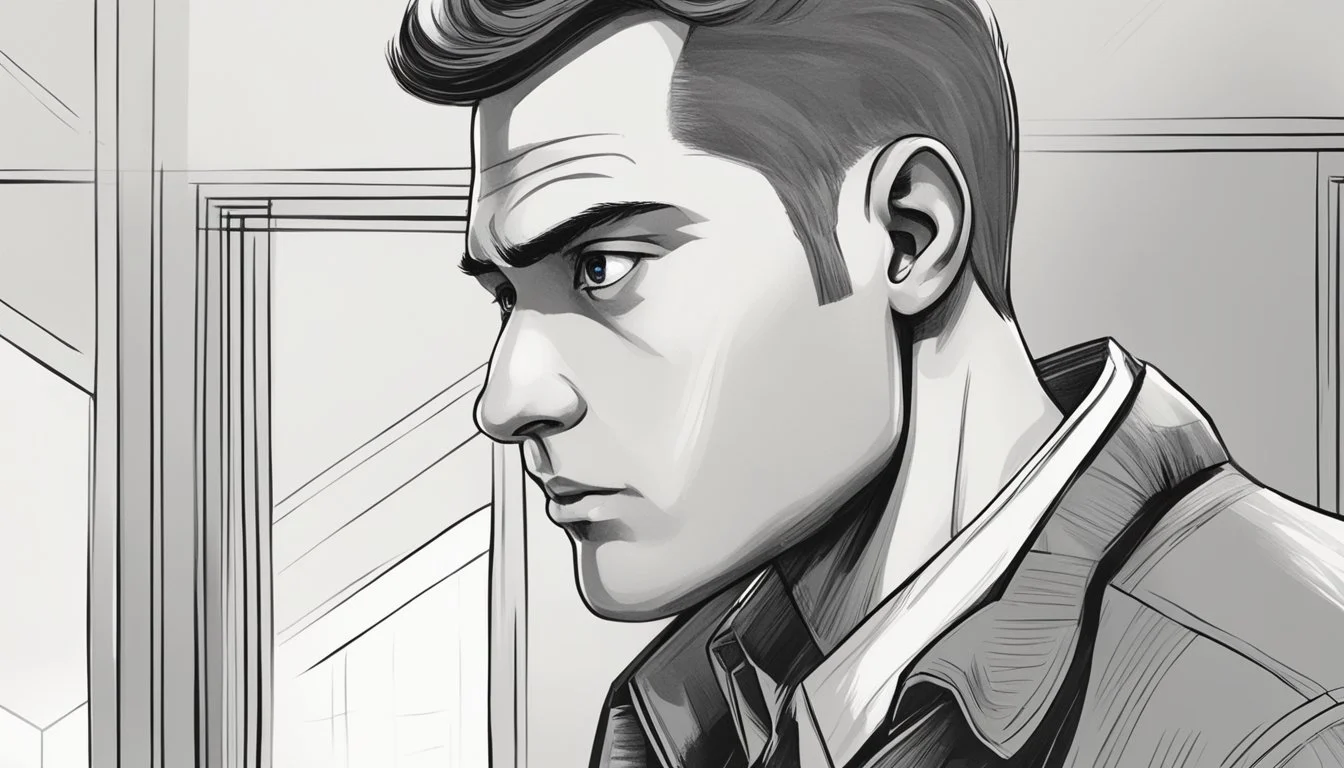Early Warning Signs of Paranoia: Detecting Irrational Fear Patterns
Paranoia can manifest in various ways, often characterized by persistent and irrational thoughts of suspicion or mistrust. These feelings can range from mild unease to intense fear, significantly impacting a person's daily life and relationships.
Common signs of paranoia include extreme suspicion of others' motives, belief in conspiracies, and constant vigilance for potential threats. Individuals experiencing paranoia may struggle to trust even close friends or family members, often interpreting innocent actions as malicious or threatening.
While occasional paranoid thoughts are normal, persistent paranoia may indicate an underlying mental health condition. Recognizing these signs early can lead to timely intervention and support, helping individuals manage their symptoms and improve their quality of life. Mental health professionals can provide accurate diagnosis and effective treatment options for those experiencing severe or chronic paranoia.
Understanding Paranoia
Paranoia involves persistent, irrational thoughts and fears of being harmed or threatened by others. It can range from mild suspicions to severe delusions that significantly impact daily life.
Definition and Overview
Paranoia is characterized by unfounded mistrust and suspicion of others. People experiencing paranoia may believe others are plotting against them, even without evidence. This condition can occur on its own or as a symptom of other mental health disorders.
Paranoid thoughts often revolve around perceived threats or conspiracies. These beliefs can be distressing and may lead to social isolation or defensive behaviors. While occasional paranoid thoughts are common, persistent paranoia can interfere with relationships and daily functioning.
Types of Paranoia
Clinical paranoia varies in severity and presentation. Paranoid personality disorder involves long-term patterns of distrust and suspicion. Individuals with this disorder often misinterpret others' actions as threatening.
Delusional disorder is characterized by fixed, false beliefs that persist despite evidence to the contrary. Paranoid delusions are a common feature of this condition. Schizophrenia can also involve paranoid symptoms, including delusions and hallucinations.
Mild paranoia may occur in response to stress or trauma. This type is usually temporary and less severe than clinical forms.
Common Signs and Symptoms
Symptoms of paranoia include:
Constant suspicion of others' motives
Difficulty trusting friends, family, or colleagues
Interpreting neutral events as threatening
Believing in conspiracies without evidence
Feeling persecuted or targeted
Defensive or hostile reactions to perceived threats
Social withdrawal or isolation
Physical symptoms may include increased heart rate, sweating, and trembling when faced with perceived threats. Paranoid individuals often struggle to accept alternative viewpoints and may become argumentative when their beliefs are challenged.
Severe paranoia can lead to delusions, such as believing one is being followed or spied on. Hallucinations, while less common, may occur in some cases of clinical paranoia.
Causes and Risk Factors
Paranoia can stem from a complex interplay of biological, psychological, and environmental factors. Understanding these underlying causes and risk factors is crucial for recognizing and addressing paranoid thoughts and behaviors.
Genetic and Biological Factors
Genetic predisposition may play a role in the development of paranoia. Individuals with a family history of mental health conditions like schizophrenia or bipolar disorder may be at higher risk. Brain chemistry imbalances, particularly involving neurotransmitters like dopamine, can contribute to paranoid thoughts.
Neurological conditions such as dementia or brain injuries can also trigger paranoid symptoms. Hormonal changes, particularly during puberty, pregnancy, or menopause, may influence paranoid thinking in some individuals.
Certain medical conditions, including thyroid disorders or vitamin deficiencies, can sometimes manifest with paranoid features.
Psychological and Social Contributors
Trauma and abuse, especially during childhood, can significantly impact a person's ability to trust others. Experiences of bullying, neglect, or violence may lead to heightened suspicion and mistrust in adulthood.
Personality disorders, particularly paranoid personality disorder, are characterized by pervasive mistrust and suspicion of others. Anxiety disorders and depression can also contribute to paranoid thoughts.
Low self-esteem and poor coping skills may make individuals more susceptible to paranoid ideation. Social isolation and loneliness can reinforce paranoid beliefs, creating a self-perpetuating cycle.
Environmental Influences
Chronic stress and high-pressure environments can trigger or exacerbate paranoid thoughts. Workplace stress, financial difficulties, or relationship problems may contribute to feelings of persecution.
Substance use, particularly stimulants like cocaine or methamphetamine, can induce paranoid symptoms. Long-term alcohol abuse may also lead to paranoid thinking.
Cultural factors and societal pressures can influence the expression of paranoia. Living in high-crime areas or experiencing discrimination may heighten vigilance and suspicion.
Exposure to conspiracy theories or misleading information through media and social networks can fuel paranoid beliefs in susceptible individuals.
Identifying Paranoia Symptoms
Paranoia manifests through distinct behavioral, emotional, and cognitive patterns. Recognizing these signs is crucial for early intervention and support.
Behavioral Indicators
Individuals experiencing paranoia often exhibit defensive behaviors. They may constantly check their surroundings for perceived threats. Avoidance of social situations or public places is common. Some might engage in excessive security measures, like installing multiple locks or surveillance systems.
Paranoid individuals may struggle to maintain relationships due to persistent suspicion. They might accuse loved ones of betrayal without evidence. In conversations, they may read hidden meanings into innocent remarks. Hypervigilance is a key sign, with the person appearing tense and on guard.
Emotional and Mental Patterns
Fear and anxiety dominate the emotional landscape of paranoid individuals. They often feel vulnerable and under threat, even in safe environments. Distrust becomes pervasive, affecting personal and professional relationships.
Anger and irritability may surface when others challenge their beliefs. Emotional reactions can seem disproportionate to situations. Feelings of persecution or being singled out are common. Paranoid thoughts can lead to social isolation as the person withdraws to feel safer.
Cognitive Aspects
Paranoid thinking involves irrational suspicions and false beliefs. Individuals may believe others are plotting against them without valid reasons. They often misinterpret neutral events as threatening or personally significant.
Cognitive distortions include:
Jumping to conclusions without evidence
Attributing malicious intentions to others' actions
Difficulty accepting alternative explanations
Paranoid individuals may fixate on conspiracy theories. They struggle to trust information from authorities or mainstream sources. Critical thinking becomes impaired as they cling to their suspicions despite contradictory evidence.
Assessment and Diagnosis
Proper assessment and diagnosis of paranoia involve a comprehensive evaluation by mental health professionals. This process typically includes clinical interviews, standardized assessments, and careful consideration of symptoms and medical history.
Professional Evaluation
A psychiatrist or clinical psychologist typically conducts the evaluation for paranoia. They assess the individual's thoughts, feelings, and behaviors. The professional explores the person's belief systems, interpersonal relationships, and daily functioning. Medical history is reviewed to rule out physical causes of symptoms. Family history may be examined for genetic predisposition to psychiatric disorders.
The clinician distinguishes between normal suspicion and pathological paranoia. They determine if paranoid symptoms are part of a broader condition like schizophrenia or a personality disorder. Differential diagnosis is crucial to identify the specific underlying issue.
Tools and Techniques
Mental health professionals use various tools to assess paranoia. Structured clinical interviews help gather detailed information about symptoms. Standardized questionnaires measure the severity and nature of paranoid thoughts.
Common assessment tools include:
Paranoia Scale
Green et al. Paranoid Thoughts Scale
Structured Clinical Interview for DSM-5 (SCID-5)
Psychological testing may be employed to evaluate personality traits and cognitive functioning. Neuroimaging techniques like MRI or CT scans can rule out brain abnormalities. Blood tests check for medical conditions that might contribute to paranoid symptoms.
Clinicians observe the patient's behavior and interactions during the assessment process. This provides valuable insights into the individual's thought patterns and social functioning.
Treatment and Management
Effective approaches to treating and managing paranoia involve a combination of professional interventions and personal strategies. These methods aim to reduce symptoms, improve quality of life, and enhance social functioning.
Psychotherapeutic Interventions
Cognitive Behavioral Therapy (CBT) is a primary treatment for paranoia. It helps individuals identify and challenge distorted thoughts and beliefs. CBT teaches coping skills and reality-testing techniques to manage paranoid thoughts.
Mindfulness-based therapies can reduce anxiety and improve emotional regulation. These approaches encourage present-moment awareness and acceptance of thoughts without judgment.
Group therapy provides a supportive environment for individuals to share experiences and learn from others. It can help reduce social isolation and improve interpersonal skills.
Pharmacological Treatments
Antipsychotic medications are often prescribed to manage severe paranoia, especially in cases of psychosis. These drugs help reduce hallucinations and delusions by balancing brain chemicals.
Antidepressants may be used if paranoia is linked to depression or anxiety disorders. They can help improve mood and reduce overall distress.
Anxiolytics might be prescribed for short-term use to manage acute anxiety associated with paranoid thoughts.
Lifestyle and Support Systems
Establishing a consistent sleep schedule and engaging in regular exercise can significantly improve mental health. These habits help reduce stress and promote overall well-being.
Building a strong support network is crucial. Trusted friends and family can provide reality checks and emotional support during difficult times.
Stress management techniques like deep breathing, progressive muscle relaxation, and guided imagery can help reduce paranoid thoughts.
Joining support groups allows individuals to connect with others facing similar challenges. This can reduce feelings of isolation and provide practical coping strategies.
Living With Paranoia
Paranoia can significantly impact daily life and relationships. It often leads to isolation and difficulties trusting others. Managing paranoid thoughts requires developing coping strategies and seeking appropriate support.
Relationship Challenges
Paranoid thoughts can strain relationships with family, friends, and partners. People experiencing paranoia may become suspicious of loved ones' intentions. This mistrust can lead to arguments and withdrawal from social interactions.
Trust issues may cause individuals to misinterpret innocent actions as threatening. They might accuse others of plotting against them or spreading rumors. These accusations can push away potential support networks.
Maintaining relationships requires open communication. Loved ones should remain patient and avoid dismissing paranoid concerns. Instead, they can gently challenge irrational thoughts and offer reassurance.
Coping Strategies
Learning to manage paranoid thoughts is crucial for daily functioning. Practicing mindfulness can help ground individuals in reality. Deep breathing exercises may reduce anxiety when paranoid thoughts arise.
Keeping a thought diary allows people to track and examine their fears objectively. This can help identify thought patterns and triggers. Cognitive behavioral therapy techniques teach how to challenge and reframe distorted thinking.
Maintaining routines provides stability. Regular sleep, exercise, and healthy eating habits support overall mental wellbeing. Limiting alcohol and drug use is important, as these can worsen paranoid symptoms.
Connecting With Resources
Seeking professional help is essential for managing paranoia. A mental health provider can offer proper diagnosis and treatment options. They may recommend therapy, medication, or a combination of approaches.
Support groups connect individuals with others facing similar challenges. Sharing experiences reduces feelings of isolation. These groups also provide practical coping tips from peers.
Community mental health services often offer additional resources. These may include crisis hotlines, educational programs, and vocational support. Accessing these services can improve overall quality of life for those living with paranoia.
Beyond Individual Impact
Paranoia's effects extend far beyond the individual, influencing societal perceptions and mental health approaches. Increased awareness has sparked policy changes and research advancements, reshaping how communities address this complex issue.
Societal Perspectives
Stigma surrounding paranoia has decreased as public understanding grows. Media portrayals now often depict paranoia more accurately, fostering empathy. Workplaces have begun implementing mental health policies that accommodate employees struggling with paranoid symptoms.
Community support groups provide safe spaces for individuals to share experiences. These groups also educate family members on how to support loved ones with paranoid tendencies.
Government initiatives now allocate more funding to paranoia research and treatment programs. This shift reflects a broader recognition of paranoia's societal impact.
Advancements in Mental Health
Research into paranoia has led to new therapeutic approaches. Cognitive Behavioral Therapy (CBT) tailored for paranoid thoughts shows promising results. Virtual reality exposure therapy helps individuals confront and manage paranoid fears in controlled environments.
Neuroimaging studies have improved understanding of paranoia's biological basis. This knowledge informs medication development, targeting specific brain regions associated with paranoid symptoms.
Mental health organizations now offer specialized training for professionals working with paranoid individuals. These programs emphasize building trust and creating safe therapeutic environments.
Digital mental health tools, including apps for symptom tracking and coping strategies, provide accessible support. Teletherapy options have expanded treatment access for those reluctant to seek in-person help due to paranoid concerns.



